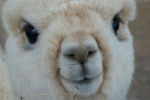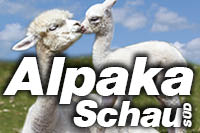Articles by Alpaca World Magazine:
A Judge's Life
Paul Cullen
To me, being asked to judge the Futurity was a great privilege. It is without doubt a premier class show, with a selection of the finest alpacas in the UK being brought forward for everybody to see, competing against each other in a fantastic environment.
Judging in the company of Mike Safley was an honour. I have heard a lot of varying comments about Mike over the years, I suppose that when you get to his level of exposure in an industry such as ours that is only to be expected. But having attended AOBA classes with Mike in the States, and shared the odd glass with him at various times over the years, I have found him to be one of the most experienced and knowledgeable alpaca judges. His depth of knowledge on all things alpaca is awesome, and he is also very good company, with a quick wit and dry sense of humour, sometimes a great benefit in the stresses of the show-ring.
Mike and I agreed on the placing of the alpacas for every class, not just the first place, but right the way down the line. I will confess that when I am working a ring with another judge, especially on such an important show as the Futurity, together with a judge with such a high profile, I can sometimes get to thinking before the show, normally about 3am in the morning, about what happens if I pick completely different placings for the alpacas than my colleague, how would I handle it and what would I do?
Those of you who watched the show will probably recall one class where Mike and I took a bit of time, OK then,- a lot of time - looking at a couple of alpacas, or so I?m informed by a friend after the show was over. I do recall the two alpacas in that class, both were impressive animals with very little to choose between them. Conformation was good, fleece coverage between the two was similar, as was fineness, density, brightness and colour conformity, but we had to choose between them, and believe me it was not easy. To me, this is the best part of judging alpacas, having to concentrate really hard to find those small but important positive traits that one animal is carrying perhaps more of, or slightly better than the other, really digging deep to justify why one alpaca can carry that first place over another.
It is in these situations that we, as judges, learn our trade, growing, developing and honing those all important assessment skills, and gaining that all important attribute called experience. There is no doubt that the more of these situations you encounter, the easier they are to deal with. I clearly remember the process Mike and I went through, (I also recall feeling pleased that he seemed to be finding it as difficult as me to make a final decision between the two), to rationalise both alpacas? positive traits and then to make a final assessment on which one should stand over the other. The final cut on this occasion was made on one alpaca carrying the character, or crimp and style, of the fleece just a little more consistently and a little further throughout the body than the other, but it was very marginal and both alpacas were pretty exceptional. I?m confident that we made the right decision, even if it did take a while, and we both felt pretty good at the end of the class, that?s what judging is all about.
A wise old judge once said to me that the only certainty with judging was that you would make one exhibitor in the class very happy, whilst the other exhibitors would be a lot less so. I?m not sure that is totally true, I was always happy to get a place ribbon when I was showing, but then again, the only reason I went into the ring as an exhibitor was because I thought I had a chance of winning, and I can totally accept that not doing so can be disappointing.
However I do find it sad that in some cases exhibitor?s disappointment at not gaining the ribbon they wanted from any particular class, championship or show can lead to some fairly derogatory remarks being made, regrettably sometimes openly and in public, about the judges, other competitors, or indeed the show organisers.
All BAS judges subscribe to a code of ethics, the detail of which is in the public domain, and whilst I will admit that sometimes it can be difficult to bite one?s tongue and keep one?s own council when events occur that you can feel deeply or passionately about, (I know that some of you will find this surprising, but even I, yes I, can sometimes be a little too open and forthright in my views and opinions), but in the main the code of ethics works well and I strongly believe that all judges do their absolute utmost to honour their position and abide by the code.
Perhaps it is now time for us to have a code of ethics for show exhibitors and competitors. As our alpaca world becomes more mature, and events such as the Futurity and other premier shows become more visible and influential on the whole of the UK and worldwide alpaca industry, it is perhaps time for us to try and avoid getting too far down the road of allowing discontented exhibitors to mimic the politics and unpleasantness sometimes experienced by other more mature showing categories, the sometimes not so exemplary examples of dog and horse shows spring to mind.
I believe that in the UK we have a fair and robust set of show rules, rules that have been developed over a period of time and take into account the experiences gained by other countries such as the USA and Australia, who have also struggled at times with their own particular show class strategies
One of those rules is the presentation of alpacas at shows in paddock or natural condition. I believe that this is a fundamental rule that we, as an industry, should try to implement in its true meaning as much as we can.
Sure we all want to see fantastic looking alpacas in the show ring. We would like them all to look absolutely stunning, to the other exhibitors, any potential customers that may be watching and the show visitors. But should we allow alpacas into the ring that have been specially spruced up to look good, with possibly an attempt to mask some of the not so graceful characteristics, such as an abundance of guard hair or other blemishes, not to mention those alpacas that may have been especially groomed with supplementary products to enhance certain ?required? characteristics?
We all know that the use of supplementary products is not allowed and any good judge will pick up the signs fairly easily and then obviously implement the rule when making the final placing of the class. I have handled Suri alpacas which have been treated with a product to enhance lustre, they look absolutely fantastic when you see then walk in the ring, but are easy to identify when you put your hands on them. I have only seen this in a country outside of the UK to date and hopefully I won?t ever see it here.
Could the seemingly increasing trend to trim and prepare alpacas for the show ring be the thin end of the wedge, and could we in the UK be in danger of the trend continuing to grow as more and more exhibitors start to feel that they should join in with the practice in order to avoid being left behind, or out of the ribbons. The current trend toward cria shearing is an obvious example, it started off fairly slowly, now more and more junior alpacas are being shown that have been shorn or trimmed within a few months of birth, specifically so that they will appear more presentable in the show ring. Where does that leave the assessment of staple length, or the ability of the owner to understand how much fibre that alpaca can produce against its peer group?
I make no apology for raising these points in this article in order to, (hopefully), spark some form of open debate involving any or all of those interested in the showing and breeding of alpacas.
I also make no apology for linking this debate with my desire to see some form of code of conduct by exhibitors and handlers at alpaca shows in the way that they deal with their own success or failure. Ideally this would be a voluntary code of conduct that all will subscribe to willingly. All of us are aware of some of the disparaging comments that are made about judges, stewards, show organisers, and others, when alpacas that are perceived by their owners or handlers to be unfairly treated within the show ring fail to be placed, or are excluded from the top ribbons by the implementation of the current rules of the BAS, I can only hope that the majority of the show going exhibitors, who abide by the rules and play fair, do not judge us all too harshly.
.
Tweet



